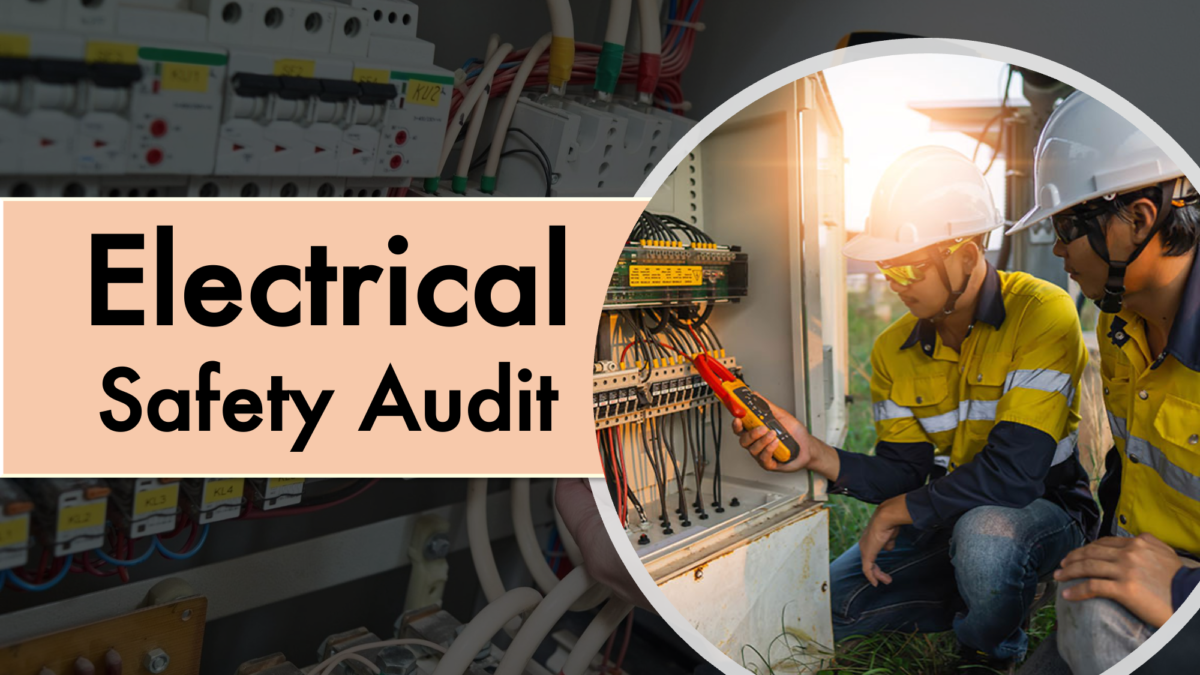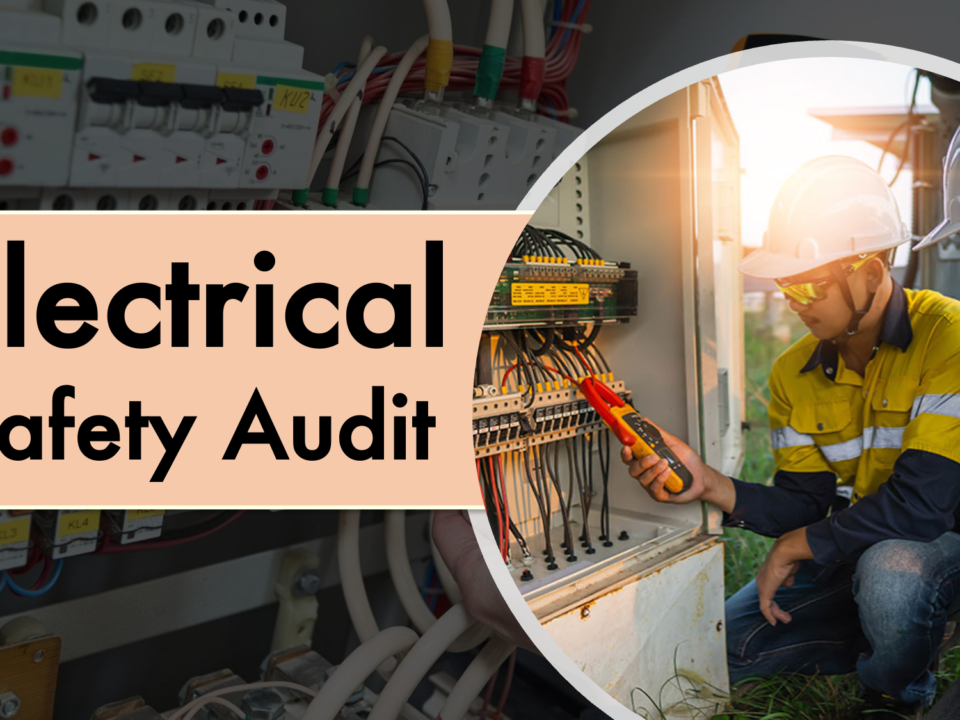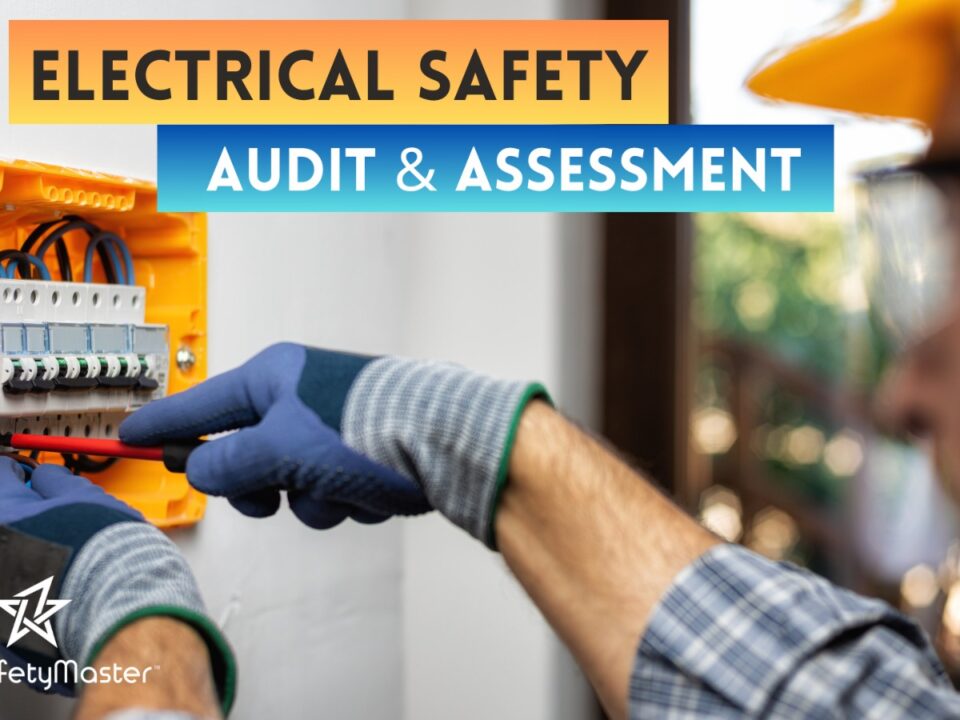A Closer Look at the Indian Standard Requirements for Electrical Safety Audits: Key Considerations for Safe Operation of Businesses

Overcoming Challenges: How Quantitative Risk Assessment Improves Risk Management Practices in Indian Process Plants
October 21, 2023Machine Guarding Assessment: Protecting Employees and Boosting Productivity in Indian Manufacturing
October 23, 2023In this article, we delve into a crucial aspect of business operations that often gets overlooked – electrical safety audits in India. Understanding the Indian standard requirements for such audits is essential for ensuring the safe operation of businesses. From examining regulations to assessing potential hazards, we explore the key considerations that must be taken into account to safeguard your organization and comply with legal requirements. By the end of this blog, you will gain invaluable insights into electrical safety audits, empowering you to make informed decisions and take proactive steps toward a secure working environment.
Understanding the Importance of Electrical Safety Audits
In the realm of business operations, safety is paramount. One area that often requires careful attention is electrical safety. With increasing reliance on electricity for day-to-day activities, businesses must ensure their electrical systems are not only efficient but also safe for their employees and customers. In this article, we will delve into the Indian Standard Requirements for Electrical Safety Audits and explore key considerations that businesses need to take into account for the safe operation of their establishments. By understanding and adhering to these standards, businesses can proactively address potential hazards and create a secure environment
Overview of Indian Standard Requirements for Electrical Safety Audits
Overview of Indian Standard Requirements for Electrical Safety Audits – The Indian Standard Requirements for Electrical Safety Audits serve as a comprehensive framework to ensure the safe operation of businesses in India. With a strong emphasis on compliance with the National Electrical Code (NEC), these standards aim to safeguard against electrical hazards and create a secure working environment for employees and stakeholders.
Under these requirements, businesses are required to have personnel trained in electrical safety, who play crucial roles in maintaining safe practices. The standards outline the responsibilities of key individuals such as electrical engineers, maintenance technicians, and safety officers. By assigning clear roles, the standards encourage accountability and promote efficient coordination that significantly reduces risks.
Moreover, the Indian Standard Requirements emphasize reviewing electrical system design and adequacy. This entails assessing factors such as load capacity, voltage levels, selection of protective devices, and emergency backup systems. By focusing on these aspects, businesses can ensure that their electrical systems are not only compliant but also capable of handling their specific operational needs efficiently.
In conclusion, adhering to the Indian Standard Requirements for Electrical Safety Audits is vital for businesses operating in India. By following these guidelines meticulously, organizations can create a secure environment that protects employees from potential electrical hazards while fostering productivity and peace of mind.
Compliance with the National Electrical Code (NEC)
Compliance with the National Electrical Code (NEC): The National Electrical Code (NEC) serves as a vital benchmark for ensuring electrical safety across various industries in India. Adhering to the NEC guidelines not only promotes a safe working environment but also enhances the overall operational efficiency of businesses. The NEC provides comprehensive regulations for electrical installations, covering aspects such as wiring methods, equipment grounding, overcurrent protection, and more.
One key consideration when it comes to complying with the NEC is understanding the specific requirements applicable to different types of businesses. For instance, the NEC considers commercial establishments distinct from industrial facilities or residential buildings. This differentiation enables businesses to address their unique electrical safety needs effectively.
By strictly adhering to the NEC regulations, businesses can mitigate electrical hazards and reduce the risk of incidents such as electrical fires or electrocutions. Moreover, compliance instills confidence in stakeholders and promotes a positive image for companies committed to providing a safe environment for their employees and customers alike.
Remember, maintaining compliance with the NEC is an ongoing practice that requires regular audits and assessments. By prioritizing adherence to these standards, businesses can stay ahead of potential risks while fostering an atmosphere of trust and security within their operations.
Understanding the Roles and Responsibilities of Key Personnel
Understanding the Roles and Responsibilities of Key Personnel: In any organization, the successful execution of electrical safety audits relies heavily on the collaboration and dedication of key personnel. These individuals play a crucial role in ensuring that all electrical systems meet the required standards, thereby safeguarding both employees and valuable assets. The first key player is the Electrical Safety Officer (ESO), who acts as the focal point for driving electrical safety initiatives. With their extensive knowledge and expertise, ESOs devise strategies to effectively implement safety measures while fostering a culture of awareness within the organization.
Next, we have facility managers who hold the responsibility for overseeing day-to-day operations. These diligent individuals work closely with ESOs to ensure that all electrical equipment is functioning optimally and meets safety requirements. Moreover, they coordinate with maintenance staff to promptly address any issues or potential hazards identified during audits. Their proactive approach ensures that any potential risks are mitigated before they escalate into major concerns.
Lastly, it is imperative to recognize the vital role that employees themselves play in maintaining a safe working environment. By actively adhering to established protocols and promptly reporting any anomalies or hazards they encounter, employees contribute significantly to fostering a culture of safety within their workplace.
By understanding and embracing their respective roles and responsibilities, these key personnel form an influential force that promotes electrical safety throughout an organization. Together, they establish an environment where every individual feels empowered to prioritize safety at all times—a collective effort that not only protects lives but also enhances productivity and fosters a sense of unity among team members.
Reviewing Electrical System Design and Adequacy
In the pursuit of a comprehensive electrical safety audit, reviewing the design and adequacy of the electrical system is paramount. This critical step involves a meticulous examination of the system’s layout, capacity, and adherence to industry standards. By doing so, businesses can ensure that their electrical infrastructure is not only capable of meeting operational demands but also prioritizes safety. Delving into the design aspect, a thorough assessment entails evaluating factors such as load calculations, conductor sizing, and protective device coordination. It involves scrutinizing blueprints and schematics to determine if they align with established guidelines and regulations. Additionally, adequate consideration must be given to factors like voltage drop mitigation measures and proper grounding techniques to guarantee smooth functioning while minimizing potential hazards.
Furthermore, in assessing adequacy, special attention is paid to evaluating whether the electrical system can effectively cater to current demands without compromising on safety margins. This includes analyzing transformer sizing relative to connected loads, determining if wiring methods are appropriate for specific environmental conditions, and ensuring sufficient power backup systems are in place for uninterrupted operations.
By thoroughly reviewing electrical system design and adequacy during safety audits – with precision and an unwavering commitment – businesses can rest assured knowing their infrastructure supports seamless operation while prioritizing the wellbeing of employees and visitors alike.
Ensuring Proper Installation and Maintenance of Electrical Equipment
Ensuring Proper Installation and Maintenance of Electrical Equipment When it comes to electrical safety, proper installation and maintenance of equipment play a crucial role in preventing accidents and ensuring the smooth operation of businesses. The Indian standard requirements for electrical safety audits emphasize the importance of adhering to specific guidelines in this area.
Every step, from the initial installation to routine upkeep, must be meticulously followed to create a safe environment. This includes conducting thorough inspections before installation, and checking for any defects or faulty components that could pose a risk. Additionally, regular maintenance should be performed on electrical equipment to identify potential issues early on.
By prioritizing proper installation and maintenance procedures, businesses can significantly reduce the chances of electrical hazards occurring. This not only protects employees and customers but also promotes a more efficient and productive work environment. With well-maintained equipment in place, businesses can focus on growth and success with peace of mind.
Remember: neglecting proper installation or maintenance can lead to costly consequences that go beyond financial implications – it can jeopardize lives. So let us appreciate the meticulousness required in these processes as they serve as guardians against mishaps while fostering an atmosphere conducive to progress and prosperity.
Identifying and Mitigating Electrical Hazards
Identifying and Mitigating Electrical Hazards: In this crucial phase of an electrical safety audit, astute attention is dedicated to identifying and mitigating potential electrical hazards that could pose risks to the safety and well-being of personnel and the smooth operation of businesses. With a meticulous approach, auditors meticulously examine the entire electrical system, leaving no stone unturned in their quest for hazard identification.
The process begins by conducting a comprehensive assessment of electrical equipment, from power distribution panels to circuit breakers, switches, and wiring systems. The auditors scrutinize each component for signs of wear and tear, loose connections, or inadequate insulation that may lead to electric shocks or fire hazards. They pay close attention to cable management, ensuring proper routing and segregation to prevent accidental contact or tripping hazards.
Next comes an evaluation of grounding systems which play a pivotal role in redirecting fault currents safely into the earth. Auditors assess the effectiveness of grounding connections, examining their integrity against corrosion or damage due to environmental factors. They also verify if equipment enclosures are properly grounded to protect against potential electrical surges.
Mitigation strategies are then devised based on identified hazards. These solutions may involve replacing faulty equipment with newer models compliant with safety standards, addressing inadequate insulation through re-wiring or implementing warning signs and barriers in areas with high-voltage equipment. By diligently tackling these hazards head-on, businesses can create a safe working environment that fosters productivity while minimizing potential risks.
Remember: A thorough identification and mitigation process not only helps safeguard lives but also ensures uninterrupted operations within businesses
Evaluating Grounding and Bonding Systems
Evaluating Grounding and Bonding Systems: Ensuring a robust grounding and bonding system is crucial for safeguarding businesses from electrical hazards. This section delves into the meticulous evaluation of these systems, focusing on their effectiveness in promoting electrical safety. A thorough examination encompasses assessing the integrity of grounding connections, verifying appropriate conductor sizing, and examining the quality of bonding between electrical equipment and structures.
Proper grounding not only protects against electric shock but also minimizes the risk of equipment damage caused by electrical surges. By meticulously scrutinizing grounding systems, businesses can identify potential issues such as inadequate electrode resistance or improper grounding conductor installation. Correcting these deficiencies enhances both employee safety and equipment longevity.
Furthermore, bonding plays a pivotal role in preventing hazardous voltage differences between conductive surfaces. Evaluating bonding connections ensures effective dissipation of stray currents, reducing the likelihood of electrostatic discharge incidents that could harm personnel or sensitive electronic devices. A meticulous evaluation confirms that all metallic components are adequately bonded to maintain equipotentiality throughout the facility, creating a resilient environment where electricity is effectively channelled while minimizing risks associated with high voltages and electrical faults.
By paying meticulous attention to grounding and bonding systems during an electrical safety audit, businesses can fortify their overall protection against electrical hazards. Implementing necessary improvements based on audit findings guarantees enhanced safety for employees, promotes uninterrupted operations, and fosters a secure environment that inspires confidence in stakeholders.
Assessing Electrical Safety Training Programs
Assessing Electrical Safety Training Programs: In the realm of electrical safety audits, evaluating the effectiveness of training programs holds paramount importance. A meticulous examination of a business’s electrical safety training initiatives ensures that employees are equipped with the knowledge and skills to navigate potential hazards. From comprehensive theoretical understanding to practical hands-on experience, a well-structured training program empowers individuals to confidently handle electrical systems with finesse and precision.
An effective assessment encompasses various elements, such as curriculum design, instructional methods, trainer qualifications, and participant feedback. The evaluation process delves into the alignment of training objectives with industry standards and regulations, ensuring that employees are well-versed in critical areas like electrical hazards recognition, safe work practices, emergency response protocols, and proper use of personal protective equipment.
Additionally, it is crucial to gauge the engagement level of participants during training sessions. Encouraging active participation through interactive discussions and practical exercises fosters a vibrant learning environment. By incorporating real-life case studies or simulating scenarios relevant to their specific work environments, businesses can enhance employees’ ability to apply their knowledge effectively.
Ultimately, a robust assessment allows for continuous improvement in training programs by identifying areas where further development may be required. Investing in ongoing education not only safeguards employees but also instills confidence within an organization that its workforce is equipped to mitigate risks effectively – resulting in increased productivity and overall business success.
Conducting Periodic Electrical Safety Inspections
Conducting Periodic Electrical Safety Inspections: As businesses strive to ensure a safe operating environment, conducting periodic electrical safety inspections emerges as a crucial component. These inspections are designed to identify potential hazards, assess the condition of electrical systems, and detect any deviations from compliance standards set by the Indian government. A thorough inspection involves scrutinizing all aspects of the electrical infrastructure, including wiring systems, distribution panels, circuit breakers, and protective devices.
During these inspections, trained professionals meticulously examine the integrity of electrical equipment and evaluate if it meets prescribed safety regulations. They inspect for loose connections or damaged insulation that may lead to short circuits or electrocution risks. Moreover, they verify that all equipment is properly grounded and bonded to prevent shock hazards. By proactively detecting and rectifying any deficiencies through periodic inspections, businesses can foster an environment where employees feel confident in their safety at all times.
While these inspections may initially appear tedious or time-consuming for businesses already dealing with pressing priorities, they ultimately serve as an investment in long-term safety and productivity. A comprehensive evaluation of electrical systems not only helps prevent accidents but also supports uninterrupted operations by minimizing the risk of unexpected power failures due to faulty components. By prioritizing such proactive measures and regularly scheduling these essential inspections, business owners can showcase their commitment towards ensuring a secure working environment for their employees while simultaneously fostering a positive company culture rooted in care and responsibility.
Incorporating Best Practices for Electrical Safety Audits
Incorporating Best Practices for Electrical Safety Audits:1. Enhancing Communication Channels: A crucial aspect of a successful electrical safety audit is fostering effective communication between all stakeholders involved. By encouraging open dialogue and regular feedback, businesses can create an environment where concerns related to electrical safety are addressed promptly and comprehensive solutions are implemented. This approach not only boosts collaboration but also ensures that everyone remains informed about any updates or changes in safety protocols, resulting in a safer working environment.
2. Implementing Continuous Training Programs: It is essential for businesses to invest in continuous training programs that focus on electrical safety awareness and best practices. By providing employees with up-to-date knowledge and skills, they become equipped to identify potential risks, adhere to established safety procedures, and respond effectively during emergencies. Regular training sessions also foster a culture of proactive involvement where individuals feel empowered to actively contribute towards maintaining a safe electrical infrastructure.
3. Embracing Technological Advancements: With the rapid advancements in technology, businesses should embrace innovative tools and techniques that enhance the efficiency and effectiveness of electrical safety audits. Integration of smart monitoring systems, such as real-time power usage monitors or automated fault detection systems, can significantly improve the identification of potential hazards while minimizing downtime due to unforeseen electrical issues. Embracing technological advancements not only streamlines processes but also showcases an organization’s commitment to staying at the forefront of safety practices.
By incorporating these best practices into their electrical safety audits, businesses can strive for excellence in ensuring a secure working environment for their employees while demonstrating their commitment towards meeting Indian standard requirements for electrical safety audits.
Conclusion
As we reach the culmination of our exploration into the Indian Standard Requirements for Electrical Safety Audits, one cannot help but be invigorated by the commitment to safety and excellence demonstrated by these guidelines. In a world where businesses are constantly evolving and expanding, it is reassuring to know that there exist comprehensive measures to ensure the safe operation of electrical systems. By adhering to the principles outlined in these standards, businesses can forge a path towards success while safeguarding their employees and assets. Let us embrace these guidelines as a testament to our collective dedication to creating secure environments that foster growth and prosperity.



